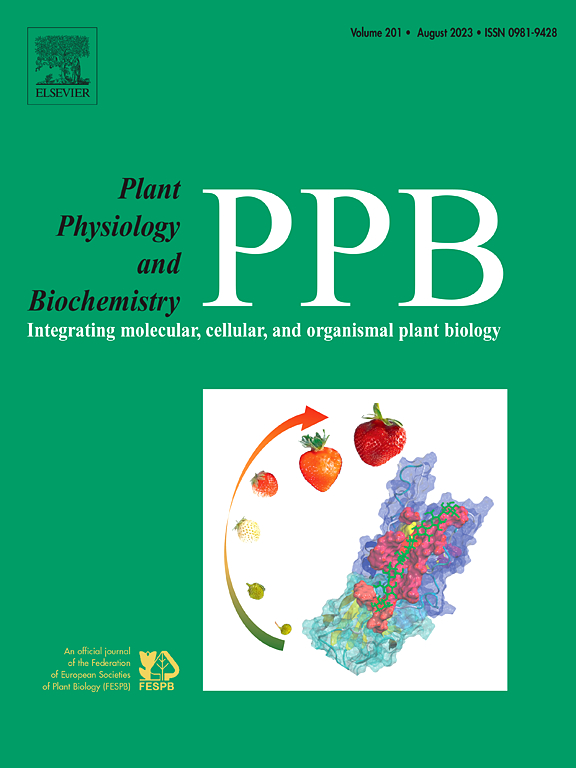Evidence of nanoCaCO3@PAE internalization in tobacco
IF 6.1
2区 生物学
Q1 PLANT SCIENCES
引用次数: 0
Abstract
Nanoparticles hold great potential as innovative agrochemicals, offering significant advantages over traditional products like insecticides, herbicides and fertilizers, which often harm soil and human health. This study investigates the effects of free aqueous pomegranate extract (PAE) and PAE encapsulated in CaCO3 nanocrystals (nanoCaCO3@PAE) on cellular uptake and internalization mechanisms in tobacco plants. Our experiments assessed the cytotoxic effect of free PAE on protoplast viability, while the negative effect was reduced in the presence of nanoCaCO3@PAE. FM4-64 labelling and secRFP-HDEL-transformed protoplasts showed an indirect increased of endocytic activity when treated with 0.25 mg/mL nanoCaCO3@PAE. After optimization of confocal microscope setting, auto-fluorescence of nano-encapsulated extracts were visible in protoplast endosome-like structures. In 3-month-old tobacco seedlings, foliar spraying of PAE or nanoCaCO3@PAE showed no visible signs of stress or necrosis 14 days after treatments, as well as chlorophyll and carotenoid content, compared to control seedlings. On the other hand, a significant increase in the amount of soluble phenols in the treated leaves, particularly in those treated with nanoCaCO3@PAE compared to their free form was observed. The use of fluorescent carbon nanocrystals, nanoCaCO3@FITC, allowed the visualization of the nanoparticles into their final destination, i.e. central vacuole, where the phenols extracted from leaves were not degraded and then probably released from nanoCaCO3@PAE due to the acidic nature of this compartment. Through the use of Tyrphostin A23, a specific inhibitor of clathrin-mediated internalization, it has been demonstrated that nanoCaCO3@FITC were internalized through clathrin-independent mechanisms.
烟草中nanoCaCO3@PAE内化的证据
纳米粒子作为创新的农用化学品具有巨大的潜力,与杀虫剂、除草剂和化肥等传统产品相比具有显著的优势,这些产品往往危害土壤和人类健康。本研究探讨了游离石榴水提取物(PAE)和包裹在CaCO3纳米晶体中的PAE (nanoCaCO3@PAE)对烟草植物细胞摄取和内化机制的影响。我们的实验评估了游离PAE对原生质体活力的细胞毒性作用,而nanoCaCO3@PAE的存在降低了这种负面影响。当0.25 mg/mL nanoCaCO3@PAE处理时,FM4-64标记和secrfp - hdl转化的原生质体的内吞活性间接增加。优化共聚焦显微镜设置后,原生质体内体样结构中可见纳米包封提取物的自荧光。在3个月大的烟草幼苗中,与对照幼苗相比,叶面喷洒PAE或nanoCaCO3@PAE后14天没有出现明显的应激或坏死迹象,叶绿素和类胡萝卜素含量也没有变化。另一方面,与游离形式相比,处理叶片中可溶性酚的含量显著增加,特别是在nanoCaCO3@PAE处理的叶片中。使用荧光碳纳米晶体nanoCaCO3@FITC,可以看到纳米颗粒进入它们的最终目的地,即中央液泡,在那里,从叶子中提取的酚没有被降解,然后可能从nanoCaCO3@PAE中释放出来,因为这个隔间的酸性。通过使用Tyrphostin A23(一种网格蛋白介导内化的特异性抑制剂),已经证明nanoCaCO3@FITC通过不依赖网格蛋白的机制被内化。
本文章由计算机程序翻译,如有差异,请以英文原文为准。
求助全文
约1分钟内获得全文
求助全文
来源期刊
CiteScore
11.10
自引率
3.10%
发文量
410
审稿时长
33 days
期刊介绍:
Plant Physiology and Biochemistry publishes original theoretical, experimental and technical contributions in the various fields of plant physiology (biochemistry, physiology, structure, genetics, plant-microbe interactions, etc.) at diverse levels of integration (molecular, subcellular, cellular, organ, whole plant, environmental). Opinions expressed in the journal are the sole responsibility of the authors and publication does not imply the editors'' agreement.
Manuscripts describing molecular-genetic and/or gene expression data that are not integrated with biochemical analysis and/or actual measurements of plant physiological processes are not suitable for PPB. Also "Omics" studies (transcriptomics, proteomics, metabolomics, etc.) reporting descriptive analysis without an element of functional validation assays, will not be considered. Similarly, applied agronomic or phytochemical studies that generate no new, fundamental insights in plant physiological and/or biochemical processes are not suitable for publication in PPB.
Plant Physiology and Biochemistry publishes several types of articles: Reviews, Papers and Short Papers. Articles for Reviews are either invited by the editor or proposed by the authors for the editor''s prior agreement. Reviews should not exceed 40 typewritten pages and Short Papers no more than approximately 8 typewritten pages. The fundamental character of Plant Physiology and Biochemistry remains that of a journal for original results.

 求助内容:
求助内容: 应助结果提醒方式:
应助结果提醒方式:


